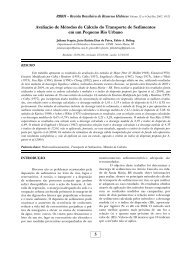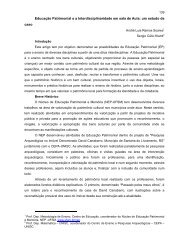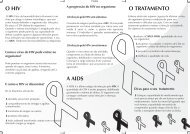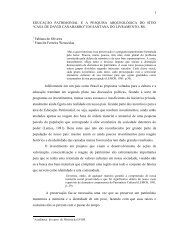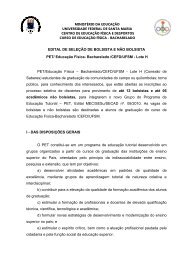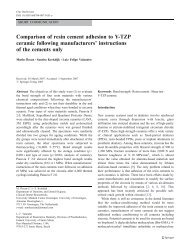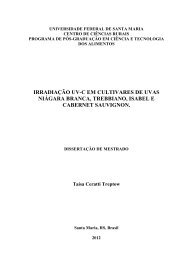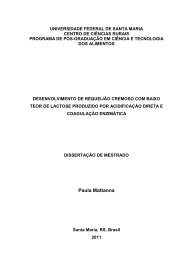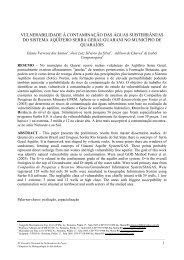The occurrence of the mouse opossum Marmosops ocellatus - UFSM
The occurrence of the mouse opossum Marmosops ocellatus - UFSM
The occurrence of the mouse opossum Marmosops ocellatus - UFSM
Create successful ePaper yourself
Turn your PDF publications into a flip-book with our unique Google optimized e-Paper software.
62110 0 W. <strong>The</strong>refore, this report extends <strong>the</strong><br />
distributional area 90 km southward from <strong>the</strong><br />
previous south-most limit. <strong>The</strong> eastern-most<br />
locality (Santa Cruz, Aserradero Potons,<br />
17105 0 S and 59134 0 W) is extended to about<br />
215 km eastward from <strong>the</strong> previous limit<br />
(Anderson 1997; Voss et al. 2004) (Fig. 1).<br />
This report also furnishes <strong>the</strong> extreme oriental<br />
distributional limits <strong>of</strong> M. <strong>ocellatus</strong><br />
since <strong>the</strong> Urucum and Amolar mountains are<br />
bordered by <strong>the</strong> Paraguay river in <strong>the</strong> east,<br />
serving most probably as a geographic<br />
barrier for this species. Hence, <strong>the</strong> same<br />
geographic attributes that define <strong>the</strong> sou<strong>the</strong>astern<br />
range limits <strong>of</strong> M. <strong>ocellatus</strong> are<br />
thought to influence <strong>the</strong> murid rodent Oryzomys<br />
nitidus distributional limits in western<br />
Brazil (see Musser et al. 1998), with both<br />
species occupying more forested biomes.<br />
Moreover, a vast flood plain, <strong>the</strong> Pantanal,<br />
is located east <strong>of</strong> <strong>the</strong> Paraguay river, which is<br />
thought to be an inhospitable, more open<br />
biome (Ab’Sa´ber 1988) toM. <strong>ocellatus</strong> based<br />
on its habitat characteristics (Emmons 1997).<br />
All surveys and revisions for <strong>the</strong> Pantanal<br />
contain no records <strong>of</strong> any <strong>Marmosops</strong> species<br />
(Vieira 1955; Alho et al. 1987; Fonseca et al.<br />
1996; Rodrigues et al. 2002; Carmignotto<br />
2004), possibly due to <strong>the</strong> stronger forest<br />
requirements <strong>of</strong> <strong>the</strong> species, which could be<br />
References<br />
Ab’Sáber, A. N. (1988): O pantanal mato-grossense<br />
e a teoria dos refúgios. Rev. Bras. Geogr.<br />
50, 9–57.<br />
Alho, C. R. J.; Lacher Jr., T. E.; Campos, Z. M. S.;<br />
Gonc-alves, H. C. (1987): Mamíferos da Fazenda<br />
Nhumirim, sub-região de Nhecolândia,<br />
Pantanal do Mato Grosso do Sul. I – Levantamento<br />
preliminar das espécies. Rev. Bras. Zool.<br />
4, 151–164.<br />
Anderson, S. (1997): Mammals <strong>of</strong> Bolivia. Bull.<br />
Am. Mus. Nat. Hist. 231, 1–652.<br />
Carmignotto, A. P. (2004): Pequenos mamíferos<br />
terrestres do bioma Cerrado: padrões faunísticos<br />
locais e regionais. Diss. <strong>the</strong>sis, São Paulo:<br />
University <strong>of</strong> São Paulo.<br />
Eisenberg, J. F.; Redford, K. H. (1999): Mammals<br />
<strong>of</strong> <strong>the</strong> Neotropics: <strong>the</strong> central neotropics.<br />
Ecuador, Peru, Bolivia, Brazil. Chicago: University<br />
<strong>of</strong> Chicago Press.<br />
ARTICLE IN PRESS<br />
Occurrence <strong>of</strong> <strong>Marmosops</strong> in Brazil 47<br />
extended for <strong>the</strong> genus (Mustrangi and<br />
Patton 1997; Fernandez and Pires 2005). If<br />
<strong>the</strong> Paraguay River is <strong>the</strong> oriental limit <strong>of</strong> M.<br />
<strong>ocellatus</strong> distribution, perhaps differences in<br />
habitat type west (mostly chacoan and<br />
forested) and east (mostly marshland and<br />
savannahs) <strong>of</strong> <strong>the</strong> river margins are <strong>the</strong><br />
explanations for <strong>the</strong> actual small mammalian<br />
species distributions in <strong>the</strong> region (sensu<br />
Myers 1982). On <strong>the</strong> o<strong>the</strong>r hand, <strong>the</strong> riverine<br />
hypo<strong>the</strong>sis (see Patton et al. 1994) would<br />
place <strong>the</strong> Paraguay River as a barrier for<br />
small mammal dispersal, but this could not<br />
explain why a number <strong>of</strong> small mammalian<br />
species occurs on both sides <strong>of</strong> <strong>the</strong> river<br />
(Ca´ceres and Carmignotto unpublished<br />
data).<br />
Acknowledgements<br />
We are grateful to UFMS, UEMS, CNPq/<br />
MCT, PROBIO/MMA and FUNDECT-MS<br />
government in Brazil for support for this<br />
study. Thanks also to MCR-Rio Tinto for<br />
logistic support, and to C. M. de Carvalho,<br />
R. A ´ vila, A. T. de Britto and V. B. de Souza<br />
for help in <strong>the</strong> field.<br />
Emmons, L. H. (1997): Neotropical Rainforest<br />
Mammals: a field guide. Chicago: University <strong>of</strong><br />
Chicago Press.<br />
Fernandez, F. A. S.; Pires, A. S. (2005): Perspectivas<br />
para a sobrevivência dos marsupiais brasileiros<br />
em fragmentos florestais: o que sabemos,<br />
e o que ainda precisamos aprender? In: Os<br />
marsupiais do Brasil: biologia, ecologia e<br />
evoluc-a˜o. Ed. by N. C. Cáceres and E. L. A.<br />
Monteiro-Filho. Campo Grande: Universidade<br />
Federal do Mato Grosso do Sul. Pp. 191–201.<br />
Fonseca, G. A. B.; Herrmann, G.; Leite, Y. R. L.;<br />
Mittermeier, R. A.; Rylands, A. B.; Patton, J.<br />
L. (1996): Lista anotada dos mamíferos do<br />
Brasil. Occas. Pap. Conserv. Biol. 4, 1–38.<br />
IBGE. (1992): Manual técnico da vegetac-ão<br />
brasileira. Man. Técn. Geociên. 1, 1–92.<br />
Musser, G. G.; Bro<strong>the</strong>rs, E. M.; Carleton, M. D.;<br />
Gardner, A. L. (1998): Systematic studies <strong>of</strong>




